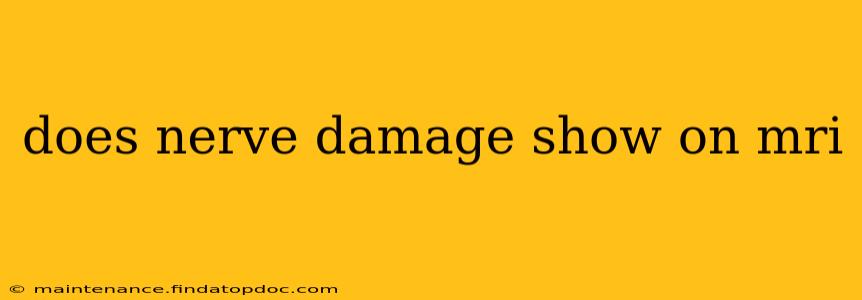MRI (magnetic resonance imaging) scans are powerful tools for visualizing the body's internal structures, but their ability to detect nerve damage isn't always straightforward. While MRIs can reveal indirect evidence of nerve damage, they don't directly "show" the nerves in the same way they show bones or major organs. Understanding the limitations and capabilities of MRI in diagnosing nerve damage is crucial.
What Can an MRI Show Regarding Nerve Damage?
An MRI excels at depicting the structures surrounding nerves. This indirect visualization can help doctors infer the presence of nerve damage. Here's what an MRI might reveal:
- Edema (swelling): Inflammation around a nerve can indicate nerve irritation or damage. The MRI can clearly show this swelling.
- Masses or Tumors: Tumors pressing on or invading nerves can cause significant damage. MRIs are highly effective at identifying such masses.
- Changes in the Spinal Cord: Conditions like herniated discs, spinal stenosis, or other spinal abnormalities can compress nerves, leading to damage. An MRI provides detailed images of the spinal cord and surrounding structures, allowing doctors to identify these issues.
- Muscle Atrophy: In cases of longstanding nerve damage, the muscles supplied by the affected nerve may atrophy (shrink). While the MRI doesn't show the nerve damage directly, it can detect the resulting muscle wasting.
- Changes in Bone Marrow: Certain conditions affecting the bone marrow can also impact nearby nerves, and these changes can be visible on MRI.
What Nerve Damage Can't Be Directly Seen on MRI?
Despite its capabilities, an MRI has limitations in detecting nerve damage:
- Direct Nerve Visualization: Nerves themselves are small and difficult to directly visualize on an MRI. The resolution isn't high enough to consistently show detailed nerve structures.
- Mild Damage: Subtle or early-stage nerve damage may not produce visible changes on an MRI.
- Specific Types of Nerve Damage: Some types of nerve damage, like those caused purely by metabolic disorders or certain types of autoimmune diseases, might not have visible structural changes detectable on MRI.
What Other Tests Might Be Used to Diagnose Nerve Damage?
Often, an MRI is used in conjunction with other diagnostic tests to confirm nerve damage. These might include:
- Electromyography (EMG): This test measures the electrical activity of muscles and nerves. It directly assesses nerve function and can detect even subtle damage.
- Nerve Conduction Studies (NCS): These studies measure the speed and strength of nerve signals, helping to pinpoint the location and severity of nerve damage.
- Physical Examination: A thorough neurological exam is crucial. The doctor will assess your reflexes, strength, sensation, and coordination to identify potential nerve issues.
Can an MRI Rule Out Nerve Damage?
While an MRI cannot definitively diagnose all types of nerve damage, a normal MRI can help rule out certain causes, like tumors or significant structural abnormalities that might be compressing nerves. However, a normal MRI doesn't exclude the possibility of other forms of nerve damage.
How is Nerve Damage Diagnosed?
Diagnosing nerve damage involves a combination of approaches. It typically begins with a detailed medical history and a thorough physical examination. Imaging tests, like MRI, may be ordered to look for underlying causes. Electrodiagnostic studies, such as EMG and NCS, are often crucial for directly assessing nerve function.
In summary, while an MRI is a valuable tool in evaluating the structures surrounding nerves and identifying conditions that might cause nerve damage, it doesn't directly visualize nerve damage in most cases. A comprehensive diagnostic approach involving multiple methods is essential for accurate diagnosis and management of nerve damage.
